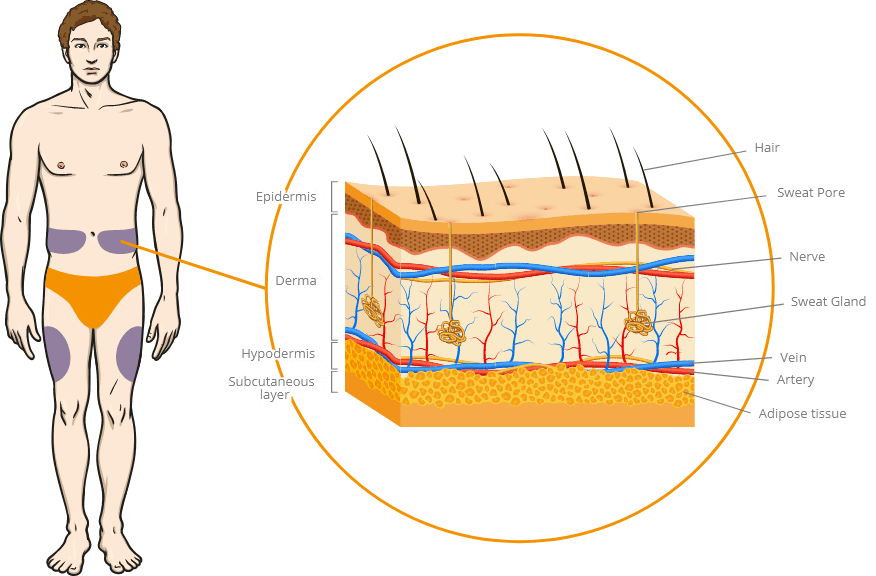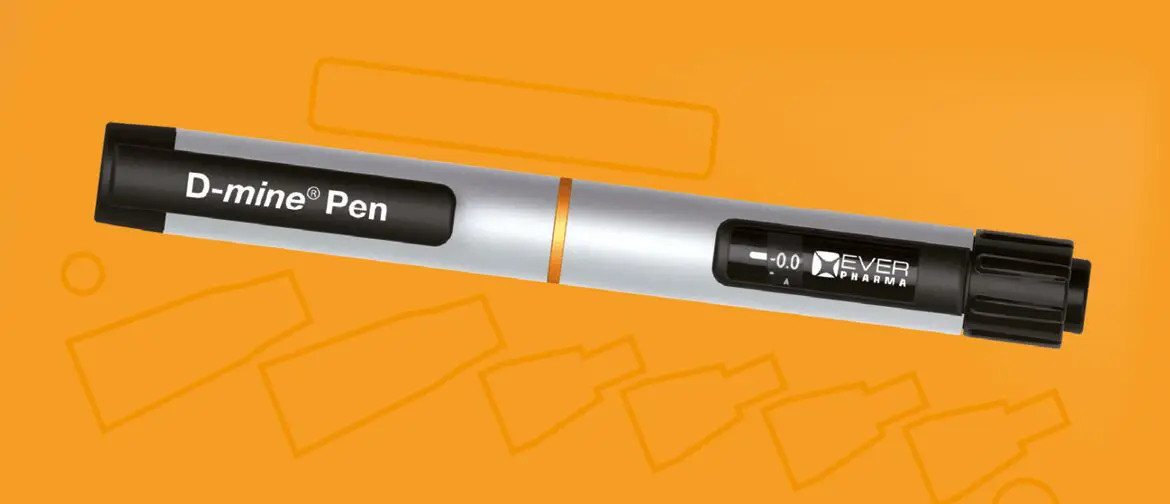
Medication for Parkinson’s disease with Apomorphine as part of the D-mine® Care therapy concept
The D-mine® Care Concept is a holistic approach for successful management of Apomorphine treatment (Parkinson’s medication) for Parkinson’s patients. It focuses on each individual in need of the therapy. The concept includes:
Our devices aim for easy-to-use and therefore may enable self-care in the home setting. Still, our teams support actively with trained healthcare professionals. In addition, we understand the novel integrated care with telemedicine opportunities to guarantee an optimal follow-up. This helps to improve patient’s and caring person’s quality of life. The elements Pharmaceutical and Medical Device of the D-mine® Care Concept are flanked by Support.
Depending on the country we are offering specific solutions to support and care with emphatic teams. Find out more by asking your local representative!
Medicines for drug therapy
Apomorphine
We start with the first element of the D-mine® Care Concept, the Pharmaceutical. Apomorphine hydrochloride hemihydrate belongs to a group of medicines known as dopamine agonists. It is a derivate of morphine, but does not actually contain morphine or its skeleton, nor does it bind to opioid receptors. Therefore, Apomorphine does not contain morphine (PIL, in current version). It is also no sedative. Apomorphine is classified as a schedule II controlled substance. Since it is only a derivate from morphine it is excluded from the list of controlled substances (DHEC, 2021).
Apomorphine is used in the Parkinson’s mdication. It is a potent emetic and should not be administered without an antiemetic. Apomorphine can be used in treating erectile dysfunction and to induce vomiting in veterinary medicine.
The first use of Apomorphine as a Parkinson’s medication was described by Schwab in 1951, but emetic properties and short half-life made oral use impractical. The commercialization of Apomorphine for Parkinson’s disease followed its successful use in patients with refractory motor fluctuations using intermittent rescue injections and continuous infusions (Stibe et al., 1988). In the past it was also used as pharmacotherapy in alcoholism and addiction (Douglas, 1899).
In ancient Egypt the pharmacological effect of the naturally occurring substance of the water lily was known for its erectogenic properties.
How do drugs as Parkinson’s medication work?
Improve Symptoms
In Parkinson’s, Apomorphine helps to reduce the amount of time spent in an ‘off’ or immobile state, by improving the motor function and activating dopamine receptors in the brain (PIL, in current version).
Slow down the progression of the disease
While Apomorphine has lower bioavailability when taken orally, due to not being absorbed well in the gastrointestinal tract and undergoing first-pass metabolism, it has a bioavailability of 100% when given subcutaneously. Subcutaneously means, that Apomorphine is injected into the area under the skin. Your doctor or nurse is supporting to recognise the signs of when to use your medicine.
Route of Administration
The second element of the D-mine® Care Concept ist the administration of Apomorphine, the Parkinson’s medication, by the help of medical devices. Apomorphine is either administered subcutaneously via small injection needle as bolus therapy or via infusion line as continuous therapy. The second happens by the help of a small portable minipump and/or syringe-driver. These two options are covered by the D-mine® Pen and D-mine® Pump in our Concept.
The amount of Dacepton® 10 mg/ml you should use and the number of injections required each day will depend upon your personal needs. Your doctor will discuss this with you and tell you how much of your medicine you should inject and how often. The amount that will work best for you will have been determined during your visit to the specialist clinic.
What does subcutaneous mean?
Subcutaneous means, that a short and extremely fine needle is stitched into the fatty tissue of the belly or outer thighs just under the skin. Apomorphine should not be used via intramuscular or intravenous route. The pictures below show the recommended injection sites and where the subcutaneous tissue is located.
Injection sites and layer of skin

Medical devices used to administer the medication
Parkinson’s disease / Apomorphine Pen
Despite optimization of oral medication Apomorphine intermittent subcutaneous injection therapy is an option for quick relief from sudden ‘off’ periods or morning akinesia.
What does intermittent injection mean?
Intermittent means “with interruptions / with leaks”. The injections are therefore given as needed, with interruptions. The amount of Dacepton® 10 mg/ml you should use and the number of injections required each day will depend upon your personal needs. Your doctor will discuss this with you and tell you how much of your medicine you should inject and how often. This is called intermittent injection on demand depending on e.g. sudden and unpredictable “off” periods and the need to administer a bolus dose. The amount that will work best for you will have been determined during your visit to the specialist clinic.
The D-mine® Pen
EVER Pharma developed the reusable D-mine® Pen injector especially for intermittent bolus injections with Apomorphine. This pen facilitates the handling of the injections and the sophisticated design of the device allows a discrete application.

In the instructions for use you find detailed information about the D-mine® Pen. The document can be found in the Download Area.
Which Parkinson’s medication can be used for D-mine® Pen Therapy?
Dacepton® contains Apomorphine solution for injection in a 3 ml cartridge. It is injected into the area under the skin (subcutaneously) by using only the dedicated D-mine® Pen. The active ingredient in Dacepton® is Apomorphine hydrochloride hemihydrate. There is 10 mg of Apomorphine hydrochloride hemihydrate in each millilitre of solution ready to use. Always use Dacepton® exactly as your doctor has told you. Check with your doctor, nurse or pharmacist if you are not sure. Before you use this Parkinson’s medication, your doctor will ensure that you tolerate the medicine and an antiemetic medicine that you need to use simultaneously (PIL, in current version).
How to set up the D-mine® Pen
Short informational clip about the most important handling steps when preparing the D-mine® Pen for use.
How to use the D-mine® Pen
Detailed explanation clip about how to prepare, set and apply the D-mine® Pen.
Parkinson’s disease / Apomorphine Pump
Patients who have shown a good “on” period response during the initiation stage, but whose overall control remains unsatisfactory using intermittent injections, or who require many and frequent injections (more than 10 per day), may be commenced on or transferred to continuous subcutaneous infusion by minipump and/or syringe-driver. The choice of which minipump and or syringe-driver to use, and the dosage settings required will be determined by the physician in accordance with the particular needs of the patient (PIL, in current version).
What does continuous infusion mean?
Oral treatments cause pulsatile stimulation and contribute to “peaks and troughs” in blood plasma levels because of the blood-brain barrier. Continuous infusion in Parkinson’s medication is the most rapid and efficient way of delivering a drug and ensures constant and consistent control. Absorption issues seen with oral medication are avoided (Baldessarini et. al, 1981). With a subcutaneous infusion Apomorphine is administered constantly. The continuous dopaminergic stimulation (CDS) closely resembles the way the brain works, by providing continuous stimulation of receptors. The short and extremely fine needle of an infusion set is positioned into the subcutaneous fatty tissue of the belly just under the skin. The infusion set is connected with a small portable minipump and/or syringe-driver.
The D-mine® Pump
The pump system is easy to operate and set up, and you will be taught how to do this. For most patients, a full day’s treatment can be set up. This enables patients to set the pump up in the morning (or have it set up by a carer) just once a day. Patients may get on with their daily activities without living after strict timetables.
A detailed description of the D-mine® Pump can be found in the Instructions for Use in the Download Area.
Which Parkinson’s medication can be used for D-mine® Pump Therapy?
Dacepton® 5mg/ml has been designed as Parkinson’s medication for continuous infusion and there is no need to dilute it before use. The liquid should not be mixed with other medicines. Dacepton® 5mg/ml is not intended to be used for intermittent injection. Before you use Dacepton® 5 mg/ml, your doctor will ensure that you tolerate the medicine and an antiemetic medicine that you need to use simultaneously. Always use this medicine exactly as your doctor has told you. Check with your doctor / nurse or pharmacist if you are not sure.
Before you use Dacepton® (Dopaceptin) 5 mg/ml, your doctor will obtain an ECG (electrocardiogram) and will ask for a list of all other medicines you take. This ECG will be repeated in the first days of your treatment and at any point if your doctor thinks this is needed. He or she will also ask you about other diseases you may have, in particular concerning your heart. Some of the questions and investigations may be repeated at each medical visit. If you experience symptoms which may come from the heart, e.g. palpitations, fainting, or near-fainting, you should report this to your doctor immediately. Also, if you experience diarrhea or start a new medication, this should be reported to your doctor (PIL, in current version). For further information on the pharmaceutical product and pump therapy, contact your doctor or nurse.
Short informational clip about the most important handling steps when preparing the D-mine® Pump for use.
Detailed explanation clip about how to prepare, fill and attach the
D-mine® Pump.

Nursing support through patient care
Learn more about the third element of the D-mine® Care Concept. Find support and informational links on this page.

Download
Find the Patient Information Letters, Instructions for Use of the Medical Devices and Supportive Documents in the Download Area.